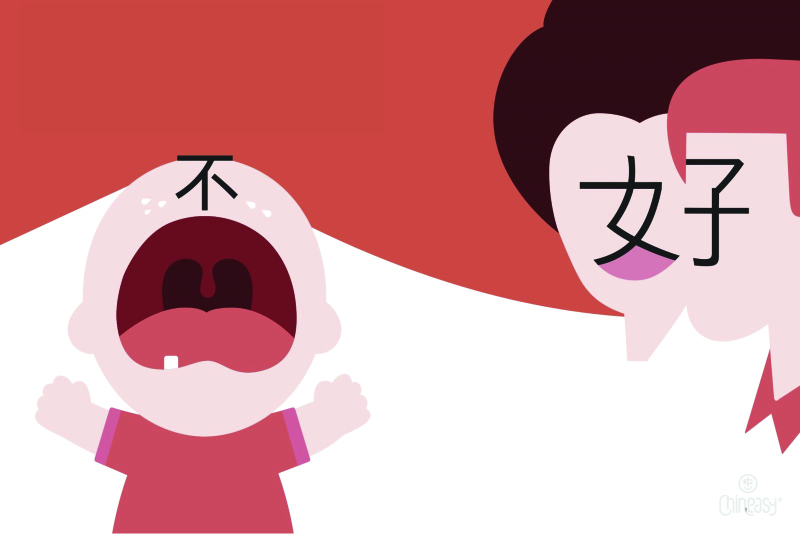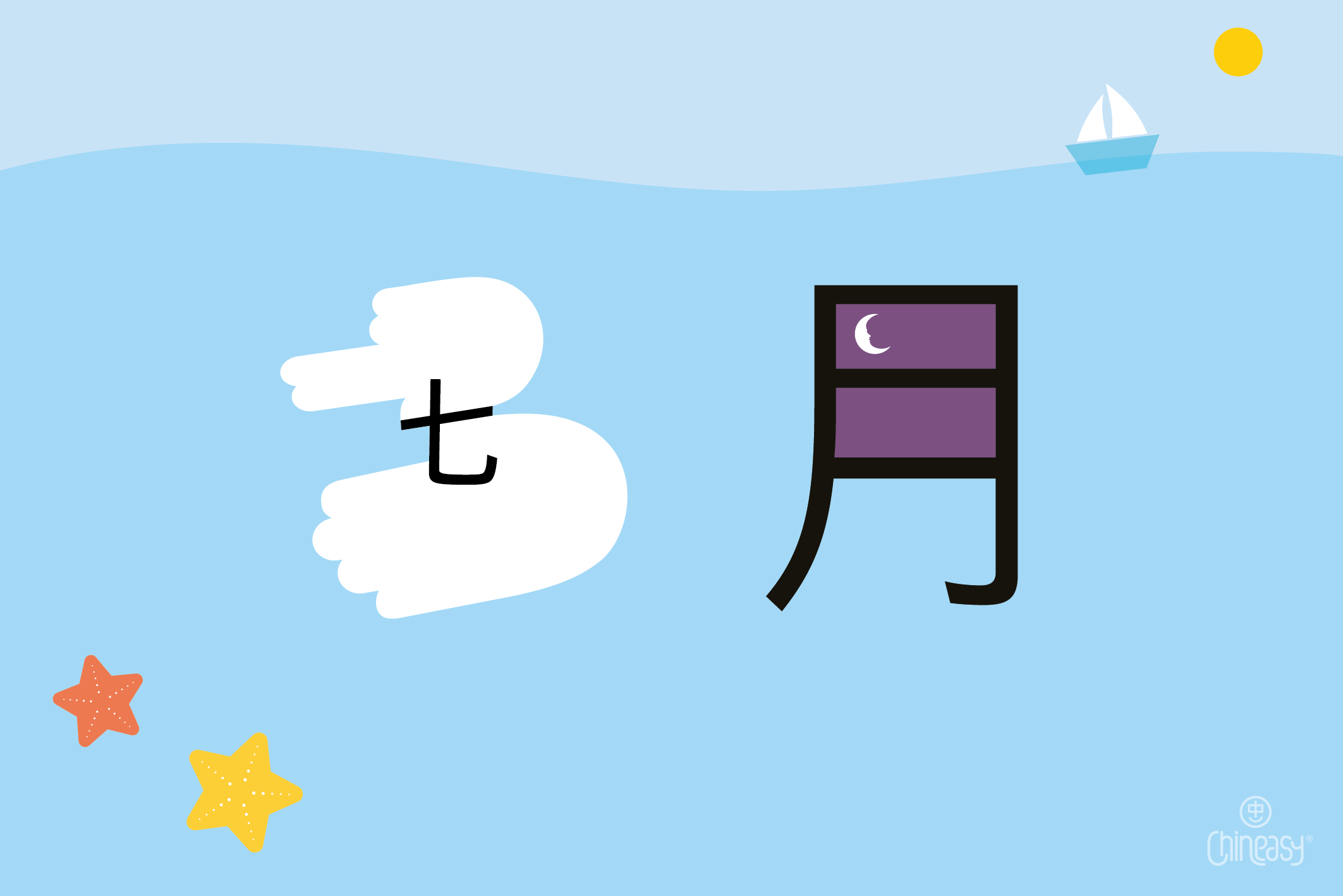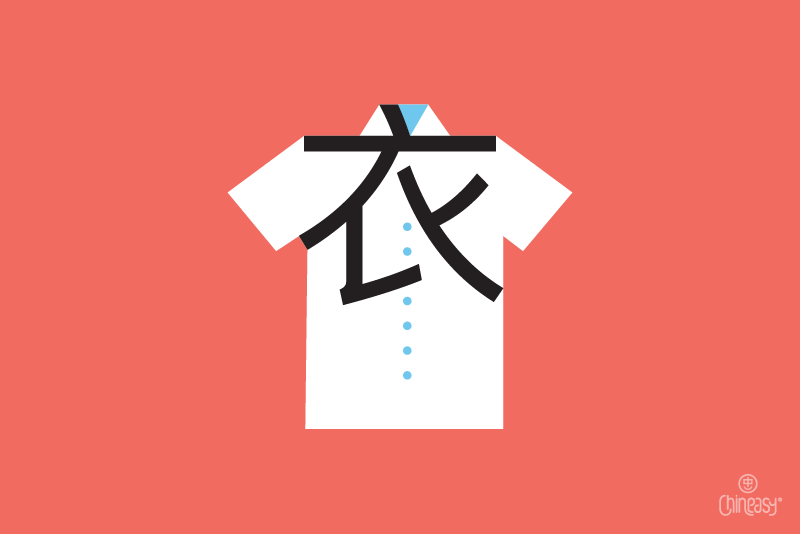Ever scratched your head wondering why 妈 麻 马 骂 (mā má mǎ mà) sound incredibly similar but mean completely different things in Chinese? Welcome to the intriguing world of Chinese tones!
If you’ve just started learning Chinese, you might’ve wondered, “Do I REALLY need to nail these tones down? Aren’t they kind of…optional?” Spoiler alert: they’re a big deal, and here’s why.
Picture this: mistakenly calling your mom (妈; mā) a horse (马; mǎ). Oops! That’s the kind of awkward situation you can find yourself in when tones get mixed up in these Chinese homophones.
While the written forms give away some hints, like 妈 (mom) versus 马 (horse), it’s the spoken word where the real challenge lies. That’s where your listening and speaking skills come into play.
Ready to dive deeper? We’ve lined up ten essential Chinese homophones you’re bound to encounter early in your language journey. Mastering these is your key to confident and mistake-free conversations!
Mom 妈 vs Horse 马
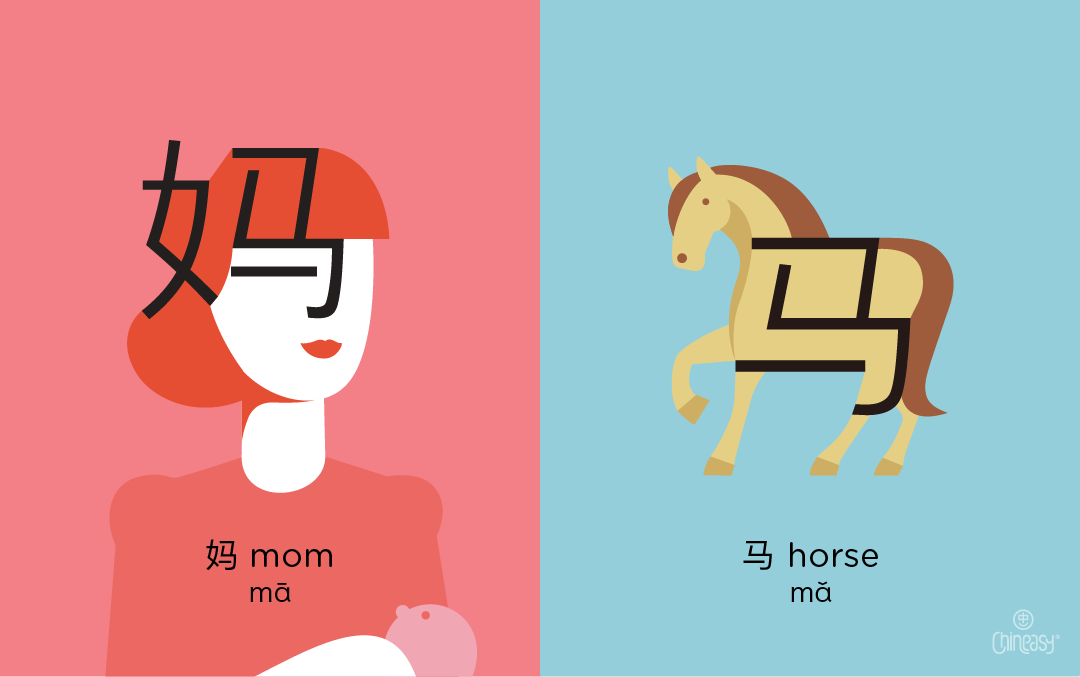
Let’s tackle the most classic mix-up: 妈 (mā; mom) and 马 (mǎ; horse). Both use the same “ma” sound, but the difference lies in their tones.
For 妈 (mā; mom), it’s all about the first tone, which is high and steady. Picture yourself saying a long, stretched-out “Ahhh” at the dentist. That’s your first tone! It’s like holding a note in a steady pitch, straight as an arrow.
Now, 马 (mǎ; horse) trots in with the third tone, and here’s where learners sometimes trip. Despite the “v” shape of its tone marker, the sound isn’t a quick bounce. Instead, the third tone actually sits at the lower end of your vocal pitch.
Try saying 马 (mǎ). Start with your voice pitched low as if you’re about to start humming, and then let it sink a bit further, right down into your chest. That’s the essence of the third tone – the lowest of your voice range!
Consider practising these tonal differences as your vocal warm-up. Nailing the 妈 and 马 distinction is your gateway to tuning your ear to the symphony of Chinese homophones.
妈 (mā; mom)
马 (mǎ; horse)
Buy 买 vs Sell 卖
Here’s a pair you’ll want to get straight, especially if you’re navigating the bustling markets or discussing finances: buying and selling! In Chinese, the words for “to buy” (买; mǎi) and “to sell” (卖, mài) may sound quite similar, but a single mix-up could swing you between profit and loss!
Just like 妈 and 马, 买 (mǎi; to buy) and 卖 (mài; to sell) hinge on the subtlety of tones. They share the same base sound, yet their meanings couldn’t be more different because of their tones.
Remember the “v” shaped marker for the third tone from the 马 (mǎ; horse) example? That’s right, you’ll use that same low pitch for saying 买 (mǎi; to buy). Try it out: let your voice remain low, and say, “mǎi.” Feels familiar, right?
Now, here comes a new challenger: the fourth tone, as in 卖 (mài; to sell). See that abrupt symbol “ˋ”? It’s all about the descent, like a decisive drop or a firm nod. Picture yourself putting your foot down in a debate and exclaiming, “No!”.
That assertive, somewhat angry intonation you use? That’s the spirit of the fourth tone! It’s the tone of determination, of drawing a line — perfect for “mài” when you’re assertively closing a deal!
Imagine if you ended up buying (买) more shares instead of selling (卖) the ones you have during a market high! Grasping the sound difference between 买 (mǎi; to buy) and 卖 (mài; to sell) ensures you stay on the right side of your transactions, whether you’re trading stocks or haggling in a local market!
买 (mǎi; to buy)
卖 (mài; to sell)
Kiss 吻 vs Ask 问
Navigating social interactions in Chinese can swing between being a breeze and launching you into blush-worthy blunders. Case in point: the subtle yet crucial difference between 吻 (wěn; to kiss) and 问 (wèn; to ask).
Picture this: you intend to say 问我 (wèn wǒ; ask me), but instead, you blurt out 吻我 (wěn wǒ; kiss me). Oops! That slip of the tongue might have you sending signals you didn’t mean to!
Here’s a quick tonal recap: the dance between 吻 (wěn; to kiss) and 问 (wèn; to ask) is a mirror image of our previous trade-related example of 买 (mǎi; to buy) and 卖 (mài; to sell). See the connection? Exactly! We’re juggling the third and fourth tones once again.
Time for a quick application exercise! Transport the same low-pitched tone from 买 (mǎi) to 吻 (wěn), feeling your voice hover at the base of your vocal range.
Then, shift gears to the assertive declination you used for 卖 (mài) when you articulate 问 (wèn). Sharp, strong, definitive – that’s the spirit!
Mastering this tone difference between 吻 (wěn) and 问 (wèn) is not just about avoiding a red face (or an unexpected smack on the cheek!); it’s about fine-tuning your communication skills, ensuring your true intentions get across correctly!
吻 (wěn; to kiss)
问 (wèn; to ask)
Beautiful 美 vs Younger Sister 妹
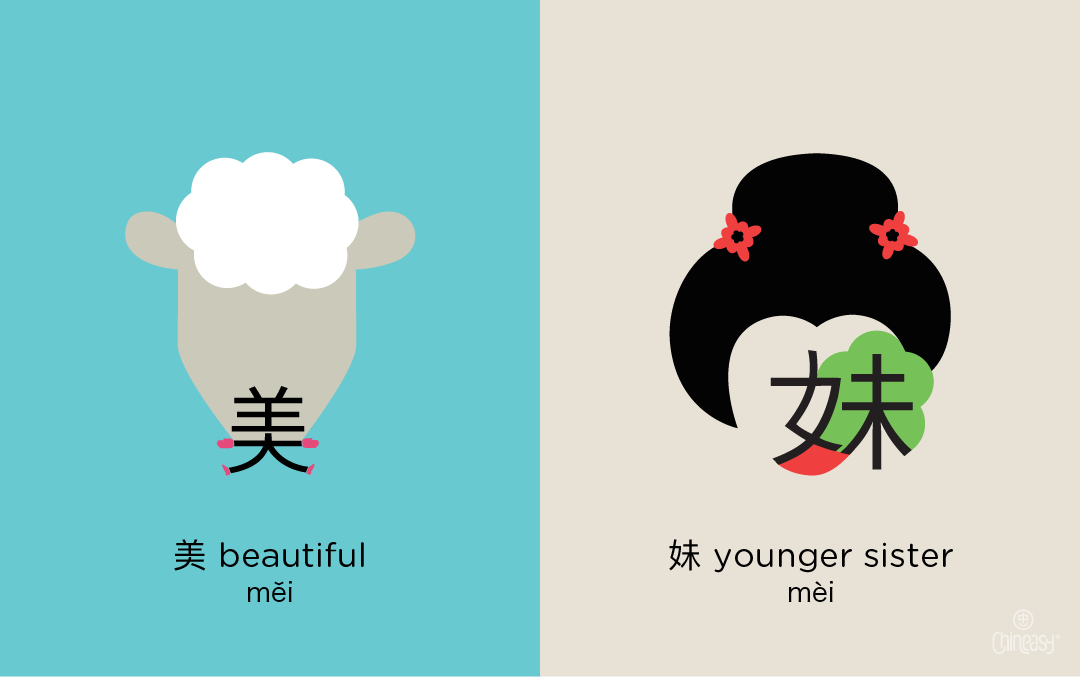
Here we go again with Chinese homophones! This time it’s 美 (měi; beautiful) versus 妹 (mèi; younger sister). You might think it’s all about saying nice things or talking about family. But be careful! If you mix up the tones, you might call someone “beautiful” when you just want to talk about your “younger sister”!
For 美 (měi), we’re using the third tone again. You’ve got this — let your voice dip down comfortably, just as you’ve practiced. Simple, isn’t it?
As for 妹 (mèi), we use the fourth tone. It’s the one that’s sharp and strong, like you’re sealing a done deal!
Notice a pattern? Exactly — the tone pair between 美 (měi) and 妹 (mèi) echoes the rhythm of our previous examples: 买 (mǎi) vs 卖 (mài) and 吻 (wěn) vs 问 (wèn). It’s the third tone versus the fourth tone: same pattern, new context. Feel like a pro yet? You should!
美 (měi; beautiful)
妹 (mèi; younger sister)
Ugly 丑 vs Smelly 臭
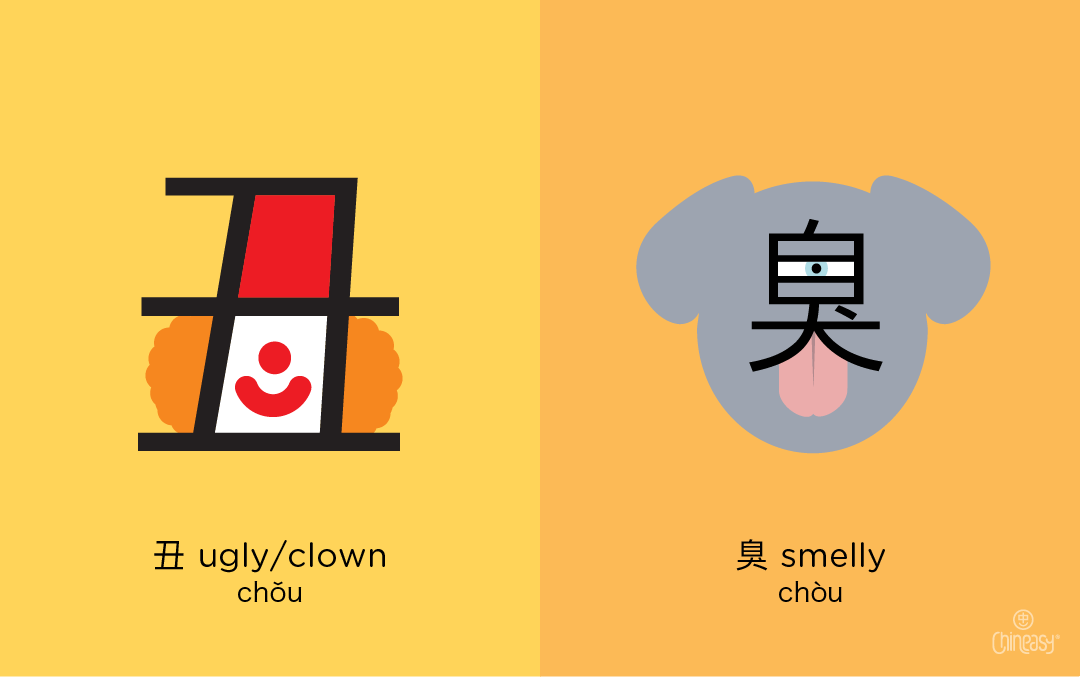
Now, we’re diving into a pair of words that you’d probably prefer to avoid in polite conversation: 丑 (chǒu; ugly/clown) and 臭 (chòu; smelly). Imagine the awkwardness if you wanted to say something smells bad (臭) and accidentally commented on someone’s looks (丑) instead!
Now, for 丑 (chǒu), you’re going to use that third tone. Yes, it’s that lowest pitch in your voice. Just find the deepest part of your vocal range. It’s NOT about diving down and rising up – don’t be misled by the “v” shape in the tone mark. Just staying low.
On the other side, 臭 (chòu) takes the fourth tone. You know this tone well by now! It’s as if you’re definitively rejecting something, strong and sure.
丑 (chǒu; ugly/clown)
臭 (chòu; smelly)
Die 死 vs Four 四
Who knew shopping in Chinese could be a matter of life and… numbers? Here’s where a small tonal mishap can cause not just a misunderstanding but outright alarm!
You’re trying to say 四 (sì; four), but with an incorrect tone, you might end up saying 死 (sǐ), the Chinese word for “die.” Yes, numbers can be a matter of grave importance here!
四 (sì; four) requires the fourth tone, which is sharp and definitive, falling like you’re making a strong point.
As for 死 (sǐ; die), you keep your voice steady and low. Getting this right can save you from some pretty awkward (and grim) mix-ups at the market!
死 (sǐ; die)
四 (sì; four)
Eight 八 vs Dad 爸
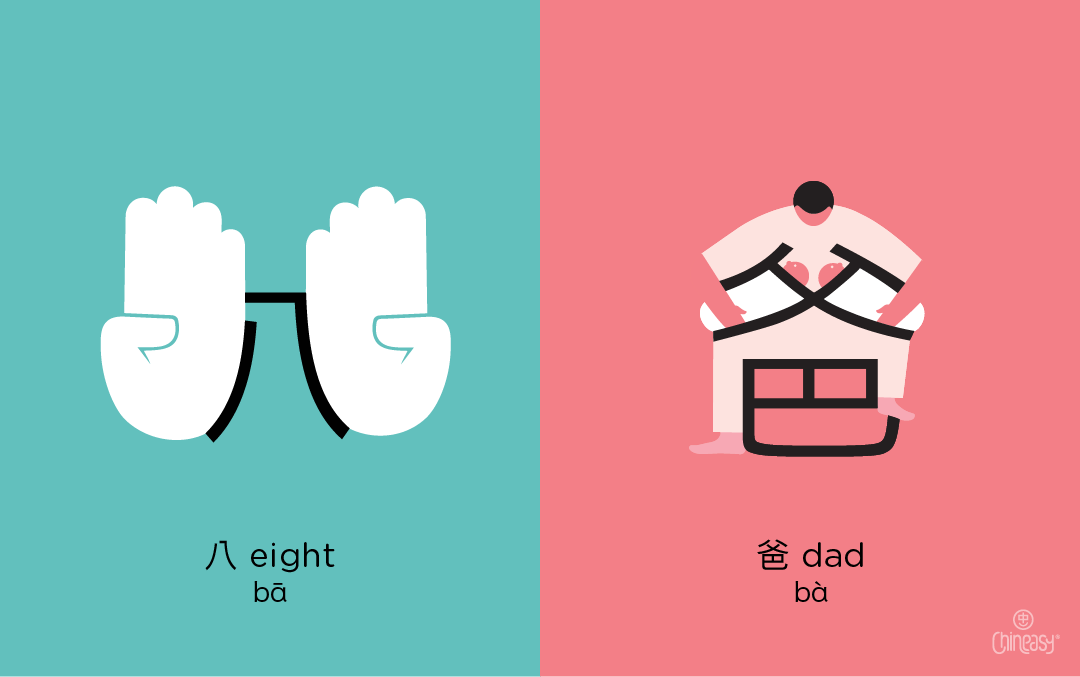
Shall we continue with the vendor theme? Here’s another way things might go wrong: This time, you want eight oranges, so you try saying 八 (bā), the Chinese word for “eight,” hoping the vendor understands. But if your tone falls sharply instead of staying high and even, it could sound like “Dad,” 爸 (bà)! Now, the vendor is wondering why you’re being so familiar!
To keep it clear, 八 (bā; eight) needs a high, even tone. It’s like holding a high note in a song, level and steady, like our very first example – 妈 (mā; mom).
But for 爸 (bà; dad), you need the fourth tone, the dropping tone, which is decisive and clear!
By nailing this subtle difference, you’ll avoid funny mix-ups and get exactly eight of what you’re shopping for!
八 (bā; eight)
爸 (bà; dad)
Ten 十 vs Yes 是
Let’s switch roles – now you’re the seller! Picture this: a customer comes and requests ten of something, using the word 十 (shí; ten). But wait, did they agree to your previous question, saying “yes,” 是 (shì)? Here’s where it gets tricky because 十 (shí; ten) and 是 (shì; yes) can sound incredibly similar in Chinese.
For 十 (shí; ten), it’s all about the second tone. Imagine your voice going up at the end of a question like you’re quite surprised. That’s the feel you want for the second tone!
On the other hand, 是 (shì; yes) is all about that fourth tone. You’ve mastered this by now! It’s the tone that’s clear and firm as if you’re saying, “Done!”
So, focus on the rising tone for 十 (shí; ten) and the definitive drop for 是 (shì; yes), and you’ll avoid any confusion from your customers.
十 (shí; ten)
是 (shì; yes)
Ice 冰 vs Cookie 饼
Who would’ve thought that getting a chilled beverage and a tasty treat could be so tonally intertwined in Chinese? Imagine being in a café, wanting some “ice” (冰; bīng) in your drink, but because of a slight tone shift, you’re served a “cookie” (饼; bǐng). It was a sweet mistake, but a mistake nonetheless!
For 冰 (bīng; ice), hold onto that first tone – as if you’re singing a high, constant note. On the other hand, 饼 (bǐng; cookie) brings in the third tone. Dive deep into your vocal range, keeping your voice low.
So, keep this in mind: it’s a high pitch for refreshing ice (冰; bīng) and a low tone when you’re in the mood for a cookie (饼; bǐng) crunch!
冰 (bīng; ice)
饼 (bǐng; cookie)
Flower 花 vs Painting 画
Let’s delve into our final set of Chinese homophones: the “flower” (花; huā) and the “painting” (画; huà).
When expressing the beauty of a 花 (huā; flower), channel that first tone. It’s a consistent, high pitch, like the brightness of a blooming petal.
On the flip side, for 画 (huà; painting), bring in the fourth tone. It has a definitive, sharp descent in pitch, much like the moment of revelation when a masterpiece unveils its story.
花 (huā; flower)
画 (huà; painting)
There you have it: 10 Chinese homophones that are crucial to get right. As you’ve seen, a tonal slip can lead to confusion or even embarrassment. For effective practice, pair words with similar tone combinations, like 妈 vs 马 and 冰 vs 饼, both transitioning from the first to the third tone.
Similarly, tackle 买 vs 卖, 吻 vs 问, 美 vs 妹, and 丑 vs 臭 to master the third and fourth tone switch. Such targeted practice not only refines pronunciation but also sharpens your listening skills, attuning your ear to the Chinese tones.
